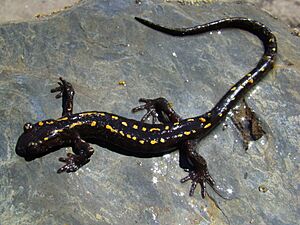Caucasian salamander facts for kids
Quick facts for kids Caucasian salamander |
|
|---|---|
 |
|
| Conservation status | |
| Scientific classification | |
| Genus: |
Mertensiella
|
| Species: |
caucasica
|
The Caucasian salamander (Mertensiella caucasica) is a special type of salamander that lives in streams. It belongs to the Salamandridae family. This salamander is a medium-sized amphibian with a thin, long body. It's a "relict species," meaning it's a survivor from an ancient group. You can only find it in the southwestern Caucasus region, specifically in Georgia and Turkey. There's also a special type called M. c. janashvilii found near Batumi and along the Black Sea coast.
Contents
Where They Live and What They Do
The Caucasian salamander likes to live near mountain streams and small, fast-flowing rivers. You can find them both in forests and high up in the mountains, even at 2400 meters above sea level. These salamanders are quite shy and mostly come out at night. They mate on land. The male has a unique bump on its tail that it uses to help with mating.
What They Eat
Caucasian salamanders mostly eat small creatures without backbones, called invertebrates. These can be found in the soil or shallow water. A big part of their diet is tiny shrimp-like animals called amphipods.
How They Reproduce
Male Caucasian salamanders have a special horn-like bump on the top of their tail. This feature is very rare and is only seen in this species and the Luschan's salamander. Because of this unique trait, these two species were once thought to be very closely related.
Mating and Eggs
Mating for these salamanders happens during the summer. The female lays about 10 to 25 large eggs. These eggs are about half a millimeter wide. She hides them in secret spots in shallow water or in damp places near streams. The baby salamanders, called larvae, hatch in one to two months. They might spend one to three winters as larvae before they change into adult salamanders. This change is called metamorphosis.
Their History and Family Tree
Even though the Caucasian salamander looks similar to Luschan's salamander (because of the tail bump), scientists have studied their DNA. This research shows that their closest relative is actually the gold-striped salamander (Chioglossa lusitanica). This other salamander lives far away in the northwestern Iberian Peninsula. These two species separated from each other about 15 million years ago.
Scientists even found an ancient Caucasian salamander fossil from the lower Pliocene period in the Polish Carpathians. This suggests that the species used to live in a much wider area before the Ice Age.
What Threatens Them
The Caucasian salamander doesn't have many natural enemies. The biggest danger to them is when their homes are destroyed. This happens because of a lot of tree cutting in Georgia and construction work in Turkey. Sadly, many areas where these salamanders live are not protected by special conservation laws.
Different Types
There are two known types, or subspecies, of the Caucasian salamander:
- M. c. caucasica (Waga, 1876)
- M. c. djanaschvilii (Tartarachvili and Bakradze, 1989)


